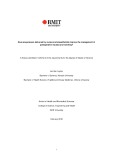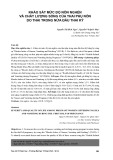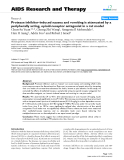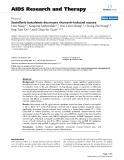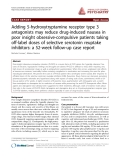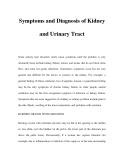
Nausea
-
The present study was embedded within a National Health and Medical Research Council funded Implementation study. This study evaluated the feasibility and clinical outcomes of acupressure as part of standard PONV management protocol through two reviews, one clinical survey, one feasibility study and one clinical audit.
 225p
225p  runthenight04
runthenight04
 02-02-2023
02-02-2023
 3
3
 2
2
 Download
Download
-
Vernonia amygdalina Delile is a shrub or small tree that is mainly grown in tropical areas of Africa. In Africa, it can be used as a traditional treatment for diabetes, emesis, nausea, dermatitis, arthristis, ascariasis, stomached, anaemia, jaundice, pneumonia, fever, tonsillitis and anti-inflammatory. The studies of the chemical components have shown that V. amygdalina contains steroids, terpenoids, saponins, polyphenolics, alkaloids, cardiac glycosides, anthraquinone and coumarins.
 7p
7p  abcxyz123_02
abcxyz123_02
 03-03-2020
03-03-2020
 13
13
 2
2
 Download
Download
-
Mục tiêu nghiên cứu: 1. Khảo sát mức độ nôn nghén của thai phụ trong nửa đầu thai kỳ bằng bộ công cụ “Rhodes Index of Nausea, Vomiting and Retching” (INVR). 2. Xác định các yếu tố liên quan và đánh giá chất lượng sống của thai phụ nôn nghén nhiều trong quý I thai kỳ bằng bộ câu hỏi “Health-Related Quality of Life for Nausea and Vomiting during Pregnancy” (NVPQOL).
 9p
9p  sieunhansoibac6
sieunhansoibac6
 21-04-2018
21-04-2018
 56
56
 2
2
 Download
Download
-
Protease inhibitor-induced nausea and vomiting is attenuated by a peripherally acting, opioid-receptor antagonist in a rat model
 8p
8p  toshiba23
toshiba23
 18-11-2011
18-11-2011
 35
35
 2
2
 Download
Download
-
Tuyển tập các báo cáo nghiên cứu về y học được đăng trên tạp chí y học Wertheim cung cấp cho các bạn kiến thức về ngành y đề tài: Scutellaria baicalensis decreases ritonavir-induced nausea...
 6p
6p  toshiba21
toshiba21
 18-11-2011
18-11-2011
 50
50
 3
3
 Download
Download
-
Tuyển tập các báo cáo nghiên cứu về y học được đăng trên tạp chí y học General Psychiatry cung cấp cho các bạn kiến thức về ngành y đề tài: Adding 5-hydroxytryptamine receptor type 3 antagonists may reduce drug-induced nausea in poor insight obsessive-compulsive patients taking off-label doses of selective serotonin reuptake inhibitors: a 52-week follow-up case report...
 4p
4p  thulanh11
thulanh11
 11-10-2011
11-10-2011
 46
46
 3
3
 Download
Download
-
Some urinary tract disorders rarely cause symptoms until the problem is very advanced; these include kidney failure, tumors and stones that do not block urine flow, and some low-grade infections. Sometimes, symptoms occur but are very general and difficult for the doctor to connect to the kidney. For example, a general feeling of illness (malaise), loss of appetite, nausea, or generalized itching may be the only symptoms of chronic kidney failure. In older people, mental confusion may be the first recognized symptom of infection or kidney failure. ...
 8p
8p  truongthiuyen2
truongthiuyen2
 09-06-2011
09-06-2011
 53
53
 4
4
 Download
Download
-
Bài này nói về một trong những thuốc trong mộṭ họ thuốc (family) rất thường dùng (hàng ngày) trong oncology để control NV (nausea and vomiting). Thật sự đây là một họ thuốc xứng đáng là breakthrough (phá nghẽn) cho NV, vì trước đó, các thuốc khác không hiệu quả bằng. Warnings (Cảnh báo) này đáng nhớ về torsade de pointes và QTprolongation. Về hypomagnesemia, complication này thường thấy trong khi dùng patinum-based chemotherapy (tubular wasting). ...
 6p
6p  sinhtobo111
sinhtobo111
 13-04-2011
13-04-2011
 34
34
 4
4
 Download
Download
-
Food Poisoning S. aureus is among the most common causes of food-borne outbreaks of infection in the United States. S. aureus food poisoning results from the inoculation of toxin-producing S. aureus into food by colonized food handlers. Toxin is then elaborated in such growth-promoting food as custards, potato salad, or processed meats. Even if the bacteria are killed by warming, the heat-stable toxin is not destroyed. The onset of illness is rapid, occurring within 1–6 h of ingestion.
 5p
5p  colgate_colgate
colgate_colgate
 21-12-2010
21-12-2010
 67
67
 3
3
 Download
Download
-
Fever is the most common presenting sign of liver abscess. Some patients, particularly those with associated disease of the biliary tract, have symptoms and signs localized to the right upper quadrant, including pain, guarding, punch tenderness, and even rebound tenderness. Nonspecific symptoms, such as chills, anorexia, weight loss, nausea, and vomiting, may also develop. Only 50% of patients with liver abscesses, however, have hepatomegaly, right-upper-quadrant tenderness, or jaundice; thus, half of patients have no symptoms or signs to direct attention to the liver.
 5p
5p  thanhongan
thanhongan
 07-12-2010
07-12-2010
 54
54
 2
2
 Download
Download
-
Inhalational Anthrax (See also Chap. 214) Inhalational anthrax, the most severe form of disease caused by Bacillus anthracis, had not been reported in the United States for more than 25 years until the recent use of this organism as an agent of bioterrorism (Chap. 214). Patients presented with malaise, fever, cough, nausea, drenching sweats, shortness of breath, and headache. Rhinorrhea was unusual. All patients had abnormal chest roentgenograms at presentation. Pulmonary infiltrates, mediastinal widening, and pleural effusions were the most common findings.
 8p
8p  thanhongan
thanhongan
 07-12-2010
07-12-2010
 68
68
 2
2
 Download
Download
-
Complications Following Hematopoietic Cell Transplant Early Direct Chemoradiotoxicities The transplant preparative regimens commonly used cause a spectrum of acute toxicities that vary according to the specific regimen but frequently result in nausea, vomiting, and mild skin erythema (Fig. 108-1). Regimens that include high-dose cyclophosphamide can result in hemorrhagic cystitis, which can usually be prevented by bladder irrigation or with the sulfhydryl compound mercaptoethanesulfonate (MESNA); rarely, acute hemorrhagic carditis is seen.
 5p
5p  thanhongan
thanhongan
 07-12-2010
07-12-2010
 64
64
 3
3
 Download
Download
-
Anaphylactic Reaction This severe reaction presents after transfusion of only a few milliliters of the blood component. Symptoms and signs include difficulty breathing, coughing, nausea and vomiting, hypotension, bronchospasm, loss of consciousness, respiratory arrest, and shock. Treatment includes stopping the transfusion, maintaining vascular access, and administering epinephrine (0.5–1.0 mL of 1:1000 dilution subcutaneously). Glucocorticoids may be required in severe cases.
 5p
5p  thanhongan
thanhongan
 07-12-2010
07-12-2010
 69
69
 3
3
 Download
Download
-
Of the complications of oral iron therapy, gastrointestinal distress is the most prominent and is seen in 15–20% of patients. Abdominal pain, nausea, vomiting, or constipation may lead to noncompliance. Although small doses of iron or iron preparations with delayed release may help somewhat, the gastrointestinal side effects are a major impediment to the effective treatment of a number of patients. The response to iron therapy varies, depending on the erythropoietin (EPO) stimulus and the rate of absorption.
 5p
5p  thanhongan
thanhongan
 07-12-2010
07-12-2010
 75
75
 3
3
 Download
Download
-
Clinical Features Symptoms in HCC patients include abdominal pain, weight loss, weakness, abdominal fullness and swelling, jaundice, and nausea (Table 88-3). Presenting signs and symptoms differ somewhat between high- and low-incidence areas. The most common symptom is abdominal pain in high-risk areas, especially in South African blacks; by contrast, only 40–50% of Chinese and Japanese patients present with abdominal pain. Abdominal swelling may occur as a consequence of ascites due to the underlying chronic liver disease or may be due to a rapidly expanding tumor.
 5p
5p  konheokonmummim
konheokonmummim
 03-12-2010
03-12-2010
 68
68
 3
3
 Download
Download
-
Nausea and Vomiting The most common side effect of chemotherapy administration is nausea, with or without vomiting. Nausea may be acute (within 24 h of chemotherapy), delayed (24 h), or anticipatory of the receipt of chemotherapy. Patients may be likewise stratified for their risk of susceptibility to nausea and vomiting, with increased risk in young, female, heavily pretreated patients without a history of alcohol or drug use but with a history of motion or morning sickness. Antineoplastic agents vary in their capacity to cause nausea and vomiting. ...
 5p
5p  konheokonmummim
konheokonmummim
 03-12-2010
03-12-2010
 70
70
 3
3
 Download
Download
-
Mitomycin C undergoes reduction of its quinone function to generate a bifunctional DNA alkylating agent. It is a broadly active antineoplastic agent with a number of unpredictable toxicities, including delayed bronchospasm 12–14 h after dosing and a chronic pulmonary fibrosis syndrome more frequent at doses of 50–60 mg/m2. Cardiomyopathy has been described, particularly in a setting of prior radiation therapy. A hemolytic/uremic syndrome carries an ultimate mortality rate of 25–50% and is poorly treated by conventional component support and exchange transfusion.
 5p
5p  konheokonmummim
konheokonmummim
 03-12-2010
03-12-2010
 61
61
 3
3
 Download
Download
-
Table 81-2 Commonly Used Cancer Chemotherapy Agents Drug Exam ples of Usual Doses Toxicity Issues Interactions, Direct DNA-Interacting Agents Alkylators Cyclophospha 2000 400– mg/m2 Marrow (relative Liver metabolism required mide IV platelet sparing) to activate to phosphoramide 100 mg/m2 PO qd Common alkylatora Mesna protects Cardiac dose) against Cystitis mustard + acrolein (high "high-dose" bladder damage Mechloretha mine 6 mg/m2 IV day Marrow Topical use in cutaneous lymphoma Vesicant 1 and day 8 Nausea Chlorambucil 1–3 mg/m2 qd PO Marrow Common alkylatora ...
 28p
28p  konheokonmummim
konheokonmummim
 03-12-2010
03-12-2010
 68
68
 3
3
 Download
Download
-
Toxicity Acute toxicity of vitamin A was first noted in Arctic explorers who ate polar bear liver and has also been seen after administration of 150 mg in adults or 100 mg in children. Acute toxicity is manifested by increased intracranial pressure, vertigo, diplopia, bulging fontanels in children, seizures, and exfoliative dermatitis; it may result in death. In children being treated for vitamin A deficiency according to the protocols outlined above, transient bulging of fontanels occurs in 2% of infants, and transient nausea, vomiting, and headache occur in 5% of preschoolers.
 5p
5p  konheokonmummim
konheokonmummim
 03-12-2010
03-12-2010
 74
74
 5
5
 Download
Download
-
Table 71-2 Deficiencies and Toxicities of Metals Element Deficiency Toxicity Tolerable Upper (Dietary) Intake Level Boron No biologic Developmental defects, male 20 mg/d function determined sterility, (extrapolated from data) animal testicular atrophy Calcium Reduced bone Renal insufficiency (milk-alkalai syndrome), mg/d 2500 (milk- Element Deficiency Toxicity Tolerable Upper (Dietary) Intake Level mass, osteoporosis nephrolithiasis, iron absorption impaired alkalai) Copper Anemia, growth retardation, keratinization Nausea, vomiting, 10 mg/d defective dia...
 6p
6p  konheokonmummim
konheokonmummim
 03-12-2010
03-12-2010
 88
88
 4
4
 Download
Download
CHỦ ĐỀ BẠN MUỐN TÌM








